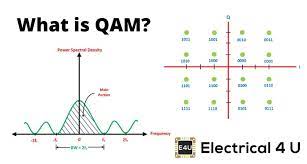

Quadrature Amplitude Modulation.
image ©Electrical 4UThere is always a demand to deliver more bits on the carrier wave. 8PSK will deliver 3 bits (8 values) but this means phase changes of 45 degrees but to extend this to 16PSK (22.5 degrees phase) and 32PSK (11.25 degrees phase) is going to be impossible to deliver.
In QAM two carrier waves are transmitted the called the 'I' wave which is a sine wave, and the 'Q' wave which is a cosine wave. These two waves are out of phase by 90 degrees.
In 16QAM 4 bits are sent per wavelength. The first 2 bits are sent on the 'I' wave and the other 2 bits on the 'Q' wave. To modulate the wave to send 2 bits per wave 16QAM uses Amplitude and Phase Shift Key. There are two possible amplitudes and the wave can have a 0 or 180 phase shift.
Once the 4 bits are split into 2 x 2 and modulated onto the waves, these are added together to be transmitted and then split apart by the receiver and simply decoded. 16PSK would need the receiver to detect phase changes of 22.5 degrees, this decoding only has to differentiate between two amplitudes anbd a 180 degree phase shift - much easier error free.
To get more bits transmitted per wave we can use 64QAM which requires 6 bits, split into 2 groups of 3. Again using 180 degree phase difference and 4 different amplitudes. 64QAM is used in 4G-LTE+ / 5G with the potential for this to be extended 256QAM (8 bits). All of this is designed to get more error free bits per carrier wave. As QAM includes amplitude, signal amplification needs to be carried out with a linear amplifier which comsumes more power, to the detriment of a mobile phone.
© mobilephonetechnology.co.uk all rights reserved 2017-2025
